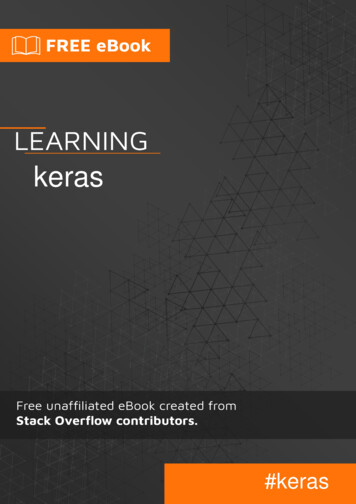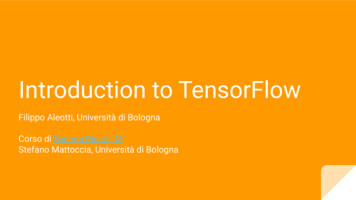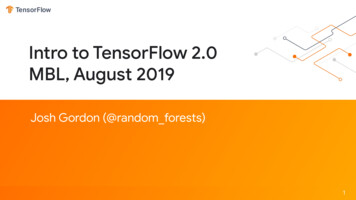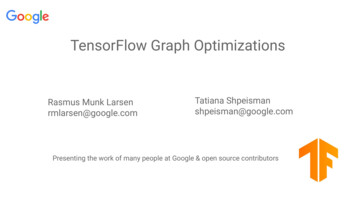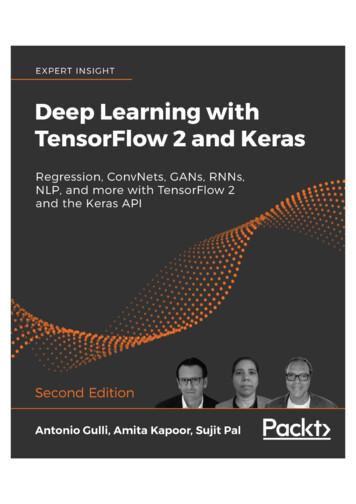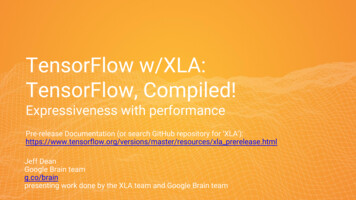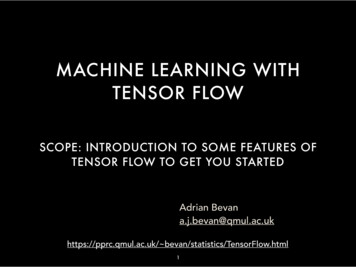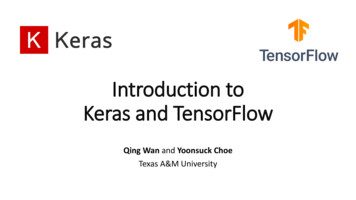
Transcription
Introduction toKeras and TensorFlowQing Wan and Yoonsuck ChoeTexas A&M University
Outline Background NVIDIA CUDA GPU Installation Basic skills to write a machine learning model A specific case: XOR gate
Keras A python package (Python 2.7-3.6) Sits on top of TensorFlow or Theano (Stopped) High-level neural network API Runs seamlessly on CPU and GPU Open source with user manual (https://keras.io/) Less coding lines required to build/run a model
TensorFlow Inherit from Theano (data flow graph) A python(3.5-3.7) package/C library Running on CPU or NVIDIA CUDA GPU End-2-End platform for machine/deep learning Multi platform (desktop, web by TF.js, mobile by TFLite) Open source with user manual(https://www.tensorflow.org/) More coding lines required to build/run a model
NVIDIA CUDA Toolkit C/C library A parallel computing platform for NVIDIA GPU Most deep learning researchers rely on GPU-accelerated computing/applications Not open source (https://developer.nvidia.com/cuda-zone) CPU vs GPU: TensorFlow training CNN model on CIFAR10 images
Anaconda3 Installation Anaconda3 Download (https://www.anaconda.com/distribution/) Installation (https://docs.anaconda.com/anaconda/install/) Restart required
TensorFlow/Keras Installation Start the anaconda navigator Windows: Start- All program- Anaconda3 Anaconda Navigator Linux: type “anaconda-navigator” under thelinux terminal Install TensorFlow and Keras Environments- choose All type “tensorflow” CPU based:tensorflow (choose 1.14)keras (2.2.4) apply GPU based: CUDA Compute Capability 3.0, better 3.7 (check more) tensorflow-gpu (choose 1.14) and kerasgpu (2.2.4), then apply
Installation Confirmed TensorFlow test code:import tensorflow as tfsess tf.compat.v1.Session()a tf.compat.v1.constant(1)b tf.compat.v1.constant(2)print(sess.run(a b)) Expect to have answer 3
Installation Confirmed Keras requires backend setting for Windows users: https://keras.io/backend/ Setting in keras.json:“backend”: “tensorflow” Keras test code:import keras Expect to seeUsing TensorFlow backend
Keras Models Two main types of models available The Sequential model (easy to learn, high-level API) A linear stack of layers Need to specify what input shape it should expect (input dimension) guide/ The Model class used with the functional API (similar to tensorflow2.0) https://keras.io/models/about-keras-models/ ide/
Keras Sequential Model Define a sequential modelmodel Sequential()mode.add(Dense(32, input dim nse(10))model.add(Activation(‘softmax’)) Compilationmodel.compile(optimizer ‘rmsprop’,loss ‘binary crossentropy’,metrics [‘accuray’]) Trainingmodel model.fit(data, one hot labels,epoch 10, batch size 32) PreditionY model.predict(X)
Case Study: XOR gateimport numpy as np# import necessary packages or APIs from kerasfrom keras.models import Sequentialfrom keras.layers import Densefrom keras.optimizers import SGDfrom keras.initializers import RandomUniform# Prepare data and labelsX np.asarray([[0, 0], [0, 1], [1, 0], [1, 1]], dtype np.float32)Y np.asarray([[0], [1], [1], [0]], dtype np.float32)# Build a modelmodel Sequential()model.add(Dense(units 2, activation 'tanh', use bias True,kernel initializer RandomUniform(minval -1, maxval 1, seed None),input dim 2))model.add(Dense(units 1, activation 'sigmoid', use bias True,kernel initializer RandomUniform(minval -1, maxval 1, seed None)))# Build optimizer and do model compilationop SGD(lr 0.01, momentum 0.0)model.compile(optimizer op,loss 'mse',metrics ['accuracy'])# Start to trainmodel.fit(x X, y Y, epochs 20000, batch size 4, shuffle True)# PredictionY model.predict(X)print("Y ", Y)
Case Study: XOR gate Training log4/4 [ ] - 2s 454ms/step - loss: 0.2538 - acc: 0.7500Epoch 2/20000.4/4 [ ] - 0s 2ms/step - loss: 0.2531 - acc: 0.5000Epoch 100/20000 4/4 [ ] - 0s 1ms/step - loss: 0.2511 - acc: 0.5000Epoch 1000/20000 4/4 [ ] - 0s 2ms/step - loss: 0.2291 - acc: 0.7500Epoch 10000/20000 4/4 [ ] - 0s 1ms/step - loss: 0.0254 - acc: 1.0000Epoch 20000/200004/4 [ ] - 0s 1ms/step - loss: 0.0254 - acc: 1.0000 PredictionY [[0.1462788 ][0.8177988 ][0.8254448 ][0.12802514]]
TensorFlow Models What is Tensor? An object (constant, scalar, vector, matrix, ) Allow to define ops ( , -, *, /, sum, max, concatenate, ) on TensorFlow Model A function with learnable parameters Maps input to an output by ops Parameters are all defined by yourself Model itselfLossOptimizerWhether a parameter is learnableData operationMore flexible than KerasMore complex than Keras
Build a TensorFlow Model Two ways to build a machine learning model Using the layers API where you build a model using layerse.g. tf.keras.layers.Dense, tf.layers.Conv2D, Using the Core API with lower-level opse.g. tf.math.add, tf.math.abs, tf.concat,
Case Study:XOR gateimport numpy as npimport tensorflow as tf# Prepare data and labelsdata np.asarray([[0, 0, 0], [0, 1, 1], [1, 0, 1], [1, 1, 0]], dtype np.float32)# Build a modelx tf.compat.v1.placeholder(tf.float32, shape [None, 2], name 'x in') # inputlabel tf.compat.v1.placeholder(tf.float32, shape [None, 1], name 'label') # labelhidden tf.keras.layers.Dense(units 2, activation tf.nn.tanh, use bias True,kernel initializer tf.keras.initializers.RandomUniform(minval -1, maxval 1))(x)pred tf.compat.v1.keras.layers.Dense(units 1, activation tf.nn.sigmoid, use bias True,kernel initializer tf.keras.initializers.RandomUniform(minval -1, maxval 1))(hidden)cost tf.compat.v1.norm(tf.math.subtract(label, pred), ord 2, name 'cost')op ng rate 0.1).minimize(cost)training epochs 20000# Set GRAM allocationconfig tf.compat.v1.ConfigProto(device count {'GPU': 1})config.gpu options.per process gpu memory fraction 0.5# Start a Session to train and testwith tf.compat.v1.Session(config config) as sess:sess.run(tf.compat.v1.global variables initializer())# Trainfor epoch in range(training epochs):loss 0for d in data:training X, training Y np.asarray(d[0:2], dtype np.float32), np.asarray(d[2], dtype np.float32)training X, training Y np.expand dims(training X, axis 0), np.expand dims([training Y], axis 0)sess.run(op, feed dict {x: training X, label: training Y})loss sess.run(cost, feed dict {x: training X, label: training Y})if epoch % 100 0:print("epoch: %d, loss %f" % (epoch, loss))# Testfor d in data:Y sess.run(pred, feed dict {x: np.expand dims(np.asarray(d[0:2], dtype np.float32), axis 0)})print("d ", d, "output ", Y)
Case Study: XOR gate Training logepoch: 0, loss 2.025534epoch: 100, loss 1.963005 epoch: 1000, loss 0.051374 epoch: 10000, loss 0.003195 epoch: 19800, loss 0.001572epoch: 19900, loss 0.001564 Predictiond d d d [0. 0. 0.] output [0. 1. 1.] output [1. 0. 1.] output [1. 1. 0.] output 58]]
Case Study: XOR gate What happen if we remove kernel initialization in both Keras modeland TensorFlow model? Try if you are interested Do we really get the right answer? Are these results stable? What’s a potential cause to this?
SummaryAs two popular deep learning packages Keras User friendly with high-level APIsQuick to get startedCoding less lines for machine learning model construction/training/testingSometimes training convergence is not stable. TensorFlow Flexible for developing new machine learning modelMulti platformCommunity supportNot friendly for new learner due to many low level APIs
Thanks
Keras and TensorFlow Qing Wan and Yoonsuck Choe Texas A&M University. Outline Background NVIDIA CUDA GPU Installation Basic skills to write a machine learning model A specific case: XOR gate. Keras A python package (Python 2.7-3.6) Sits
